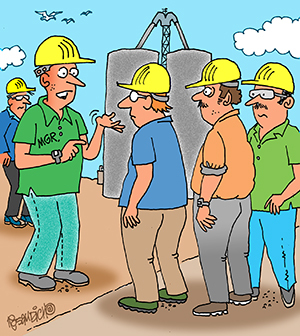Talking with employees helps identify exposure in the workplace

Every organization has an auditing component as part of its safety program. Audits are a useful tool for identifying hazards, evaluating regulatory compliance, and developing safety improvement plans. They are necessary but often focus on conditions rather than exposure. There are numerous ways to identify exposure in the workplace, but the simplest method is conversation-based safety.

Traditional safety auditing focuses on hazardous conditions that could cause an injury. There is nothing wrong with this approach. Hazardous conditions routinely should be identified and eliminated or controlled.
However, not all conditions involve exposure. Exposure occurs when a person or group of people are exposed to a hazard. Consider this simple example. An auditor identifies an electrical junction box with a missing cover located high on the wall in the maintenance shop. This electrical hazard should be fixed, but unless employees are exposed to it, there is minimal risk of injury. We all have seen safety audit reports with a plethora of similar examples.
Exposure-based Thinking
My first introduction to the importance of focusing on exposure was in 2006. One of my coworkers was killed in a grain engulfment. As a result of this tragedy, we began questioning everything we were doing. We brought in the leading behavior-based safety company at the time to assist us with transforming our approach. We found that we had an excellent auditing process that focused on conditions rather than exposure. We also transitioned from viewing employees as part of the problem to viewing them as part of the solution, because employees are the experts in the field.
I recall a recent conversation with a feed mill employee who explained how he had to climb across the top of a trailer to monitor the loading process. This is something I never would have identified during an audit without asking a simple question.
Our lead consultant challenged us to facilitate conversation with front line employees and formulate lists of the activities that employees felt put their safety at risk or, in other words, activities they felt could seriously injure or kill them. This is exposure-based thinking. The conversations were eye-opening. The employees discussed items that never would have been identified during a traditional safety audit.
After the discussions, the items were prioritized, and action plans were put in place to eliminate, reduce, or control the exposure. These high-exposure activities were always there; we either didn’t witness them or ask the experts for their perspective.
Conversation is Key
Including conversation-based safety as part of your auditing process or daily routine is not as difficult as one may think. It just takes a little time and consistency. It involves spending a few minutes with employees during the audit, preferably in their work environment, to ask simple questions such as, “Are there any jobs you perform here that make you nervous or cause concern for your safety or your coworkers?” Employees are sometimes cautious about answering these types of questions, but I find that providing an example often breaks the ice. For instance, “I talked to another employee that indicated that he has to climb out onto an area with no guardrail to grease a bearing.”
I recall a recent conversation with a feed mill employee who explained how he had to climb across the top of a trailer to monitor the loading process. This is something I would never have identified during an audit without asking a simple question.
You might be asking, “I don’t perform safety audits, so how can I use conversation-based safety to identify exposure?” Fortunately, this is not complicated either. As mentioned earlier, it only requires dedicating a few minutes each day to talk to employees individually or in a group setting. For example, many facilities have pre-shift meetings to discuss the activities for the day. During this meeting, simply discuss each task. Break it down into steps, hazards, and safe practices or controls. Start the conversation by asking “What are the steps, what are the hazards, and what are we going to do about it.”
The beauty of these conversations is that they can identify exposure that might not be identified during a traditional safety audit as well as demonstrate that safety is important enough to discuss before starting work each day.
There is also power in repetition. The more we discuss or engage in any activity the more it becomes intuitive or instinctual. In other words, these conversations begin taking place without conscious effort.
The conversations were eye-opening. The employees discussed items that would never be identified during a traditional safety audit.
Non-traditional approach. There are those who may read this and think this approach seems too simple, because safety is a complex business. Safety professionals are often technical by nature. Including non-traditional approaches, like conversation-based safety, is challenging not because it is technical in nature but because it involves conversations, which sometimes can be uncomfortable.
With commitment and a little practice, these conversations become second nature, and you will find that employees appreciate the concern. Safety does not have to be difficult – simple conversations can prevent injuries and save lives.
Joe Mlynek is president and safety and loss control consultant for Progressive Safety Services LLC, Gates Mills, OH; 216-403-9669; and content creation expert for Safety Made Simple, Olathe, KS.
The National Grain and Feed Association’s (NGFA) fourth annual Harvest Safety Week is slated for August 22-26.
Each day during the week, NGFA will deliver harvest safety education focusing on heat illness and injury prevention. New resources will include a webinar with legal experts on OSHA rules and enforcement, an interview with OSHA regulators on the new heat injury and illness enforcement program, and more.
For more info, go to ngfa.org.
From July/August 2022 Grain Journal Issue
